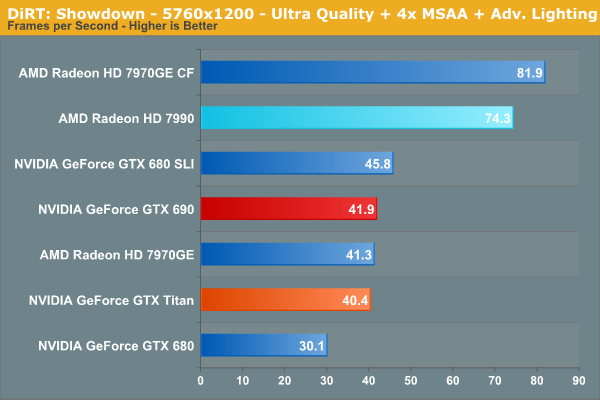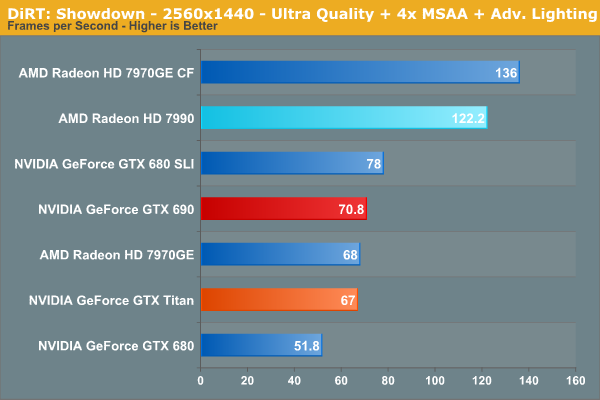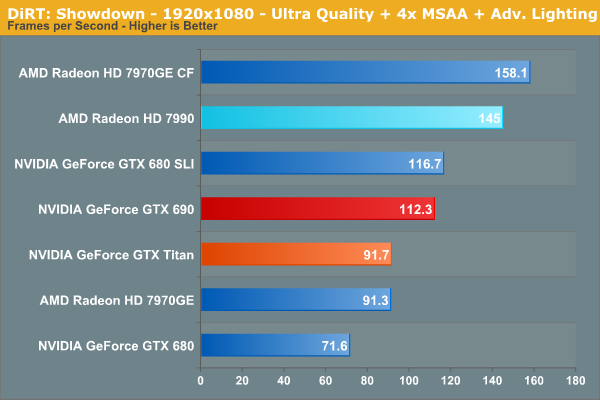AMD Radeon HD 7990 Review: 7990 Gets Official
by Ryan Smith on April 24, 2013 12:01 AM EST- Posted in
- GPUs
- AMD
- Radeon
- Radeon HD 7000
- Tahiti
DiRT: Showdown
Racing to the front of our benchmark suite is our racing benchmark, DiRT: Showdown. DiRT: Showdown is based on the latest iteration of Codemasters’ EGO engine, which has continually evolved over the years to add more advanced rendering features. It was one of the first games to implement tessellation, and also one of the first games to implement a DirectCompute based forward-rendering compatible lighting system. At the same time as Codemasters is by far the most prevalent PC racing developers, it’s also a good proxy for some of the other racing games on the market like F1 and GRID.



DiRT: Showdown is something of a divisive game for benchmarking. The game’s advanced lighting system, while not developed by AMD, does implement a lot of the key concepts they popularized with their Leo forward lighting tech demo. As a result performance with that lighting system turned on has been known to greatly favor AMD cards, which is exactly what’s going on here. But since we’re looking at high-end cards there’s little reason not to be testing with it turned on since even a lone GTX 680 can push 30fps with 5760 with these advanced effects turned on.
In any case, 7990 completely clobbers everything else here short of the 7970GE CF. As heavy as the load is from turning these advanced effects on, the 7990 is still more than fast enough to crack 60fps even at 5760.










91 Comments
View All Comments
Plattypus - Wednesday, April 24, 2013 - link
There's a typo on the Specification Comparison chart, you put 7970 instead of 7990 for the first one.Great review!
deestinct - Thursday, April 25, 2013 - link
There is no typo. It IS 7970 CF. CF stands for CrossFire, which means two 7970s. Therefore the comparison makes sensedeestinct - Thursday, April 25, 2013 - link
Ah sorry ignore my previous comment....i misunderstood what you saidjust4U - Wednesday, April 24, 2013 - link
One thing that bother's me about this and Nvidia's offering. You sort of "hope" (expect.. would be better..) that these types of cards would bring something more to the table besides just a dual stack of their top end card. Higher clocks, better memory.. something.jeffkibuule - Wednesday, April 24, 2013 - link
Power savings compared to 2 cards in SLI/CrossFire. Ability to fit in a smaller chassis. Use of the best binned chips possible. But yeah, it really is for the 1%.mr_tawan - Wednesday, April 24, 2013 - link
Single card also means no need for SLI/Cross Fire mainboard (which save money a bit).Rookierookie - Wednesday, April 24, 2013 - link
I don't know if you are spending $999 on your graphics card that saving money is really an issue. You are not likely to be using a low-end motherboard, and many of the high end motherboards support SLI/Crossfire anyway.just4U - Wednesday, April 24, 2013 - link
The power draw appears to be (in my opinion) partially due to the lower speeds. The cards are for a select crowd but I don't see the draw. There should bring something new to the table which would help to entice buyers.Ktracho - Wednesday, April 24, 2013 - link
There is a fair amount of variability in power consumption from one chip to another. Always choosing two chips that are on the low power side makes a significant difference compared to two chips chosen at random, because in the latter case, the design has to account for the worst case - two chips that are on the high power side.stren - Wednesday, April 24, 2013 - link
5 real monitor outputs and SFF is what it's about for those with unlimited cash, otherwise you'd be better off with mulitple lightnings or matrix cards. Until they support 2D lightboost then I'll be sticking with Nvidia.